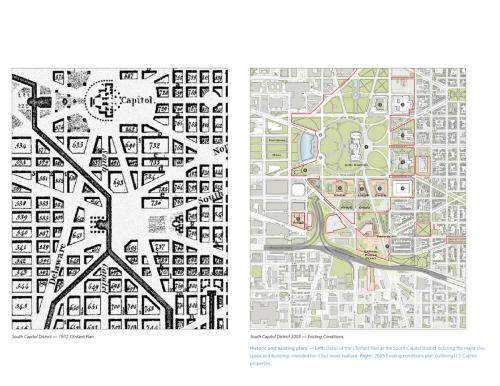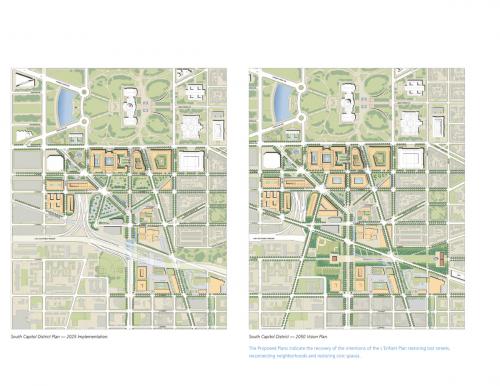
House Office Buildings Facilities Plan and Preliminary South Capitol Area Plan
Location: Washington D.C. South of Capitol Building
The U.S. Capitol Complex in Washington D.C. is one of the most significant and sensitive urban places in our country. The facilities serving the U.S. House of Representatives comprise the Capitol Complex's largest component. The project defines a vision for fulfilling the current and future space and functional needs of the building, serves as the basis for organizing, budgeting, and funding its long-range capital improvements, and establishes an interface with the future re-development of the South Capitol Area from the U.S. Capitol Complex to the Anacostia River.
The project area comprises the 177-acre South Capitol Area, and focuses on land within it that is part of the U.S. Capitol Complex, containing some 2.56 million square feet and 5,772 parking spaces assigned to the House, whose 2025 needs are projected to grow to 3.16 million square feet and 7,238 parking spaces. The South Capitol Area is currently experiencing great development pressures as it emerges from decades of neglect and many insensitive infrastructural and urban renewal interventions.
The goals, as outlined by Congress, included accommodating growth, improving security, improving transit links, preserving historic assets, upgrading open spaces, complementing new urban development south of the Complex, and developing an overall sustainability framework for the district. The plan also looks beyond 2025 to 2050, to the vision of the National Capital Planning Commission's Legacy Plan, anticipating the removal of a railroad viaduct and the I-295/395 superstructure. The proposed extension of the Canal Park will complete the integration of the South Capitol District with the U.S. Capitol Complex, to finally heal a scarred historic urban fabric.
Recommended Concept for the Facilities Master Plan
First, it was recommended that, in order to maintain critical functional proximities, existing Member suites would continue to be located in the three existing office buildings closest to the House chamber in the Capitol. In order to alleviate crowding in the Member Office suites, the plan recommends that suites be enlarged from three to four rooms. This recommendation was reached after a detailed space programming study that took into account current and future needs.
Second, in order to reduce the security risk inherent in the 2,180 parking spaces below the Rayburn building (which also needs major rebuilding due to structural deterioration over time from road salt, etc.) it was recommended that two new above-grade parking structures be built, and that the vacated space in Rayburn be rebuilt as committee hearing rooms and staff space. Since Rayburn is built into the slope of Capitol Hill, a significant portion of the building devoted to parking is actually above grade, and windows therefore can be added for the new office space. Additional communal space inside the three principal House Office Buildings can be added by roofing over interior courtyards. The new garages are to be located between the the buildings that comprise the main House office complex and the Ford House Office Building, which accommodates those functions of the House that do not need to be immediately adjacent to the main complex. The new parking is thus better located to serve Ford and the adjacent existing FDA building, which will be renovated for the use of the House. The new east-west garage, built on air-rights above I-395, will also perform an important urban design function - defining the southern boundary of existing Bartholdi Park, and linking the Ford/FDA building with the main office complex. The above moves will accommodate the space needs of the House for the next twenty years. The two existing freestanding House garages to the south of Rayburn and Longworth, which have roof-top gardens, thus remain as future expansion sites for the House over the next 45 years. In addition, a Transit and Arrival Center is proposed to the south of the Cannon House Office Building above the Capitol South Metro Station.
Recommendations for the Project Urban Context
The Plan includes accommodation of the needs of the House and some ancillary Capitol facilities. The plan also addresses the urban design issues of preserving and enhancing the historic and symbolic importance of the Capitol Complex, the relationship of the House Office Buildings to the city, security, sustainability, and traffic circulation.
As shown on the 2025 Plan and especially the 2050 Plan, the recommendations for the South Capitol area will allow significant repairs to the urban fabric the 2050 Plan assumes the elimination of the rail viaduct (which is a security problem) placing the eastern portion of the Southeast Freeway in a tunnel, and the reintroduction of vestiges L'Enfant's canal system in the form of connected landscaped pedestrian spaces with water features that will stretch from Capitol Hill to the Anacostia River. Placing the freeway underground will allow reestablishing Virginia Avenue and development of a new G street Park that echoes a key feature of the L'Enfant Plan in this part of Washington.
The plan includes the use of green roofs, porous paving, and the establishment of a system of green infrastructure that includes bio-retention and bio-filtration features, such as the new network of water-oriented parks that are specially designed to naturally filter the area's storm water runoff. The existing buildings are due for major renovations that address deferred maintenance issues. These renovations provide opportunities for improving energy conservation, air quality, and employment of other green building strategies like the incorporation of green roofs.
Transect Zone(s): T6 core.
Status: Plan Approved
Project or Plan's Scale: Region
Features: Civic buildings & parks, Green buildings.
Land area (in acres): 177
Total built area (in sq. ft.):
Total project cost (in local currency):
Retail area (in sq. ft.):
Office area (in sq. ft.):
Industrial area (in sq. ft.):
Number of hotel units:
Number of residential units (include live/work):
Civic uses (type and size): Federal Government
Parks & green space (in acres):
Project team designers: Office of the Architect of the Capitol; Wallace Roberts & Todd, LLC (Images); Bay Area Economics (Real Estate Consultant); Booz Allen Hamilton, Inc (CAFM, GIS, Telecommunication); Carter Goble Associates, Inc. (Space Programming); Gorove/Slade Associates, Inc. (Transportation, Traffic, Parking); Hanscomb Faithful & Gould (Cost Estimates); Louis Berger Group, Inc. (Habitat, Archeological, Utilities, Website); System Planning Corporation (Security)
Project team developers: Project Owner: Office of the Architect of the Capitol
Previous site status:
Starting/Ending date of construction/implementation: -





